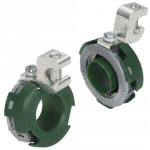ceb58
Senior Member
- Location
- Raeford, NC
I looked at a job today where the installers used only the grounding bushing to connect to the chase nipples from LB's coming into the boxes. The connections were tight but am I wrong in thinking there should have been a lock nut then the grounding bushing?



